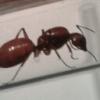Body:
1. Location of collection: park Memphis, Tennessee, USA
2. Date of collection: 9.25.18
3. Habitat of collection: hillside shaded by a large tree with poor grass cover.
4. Length: 5 - 6 mm
5. Coloration: dark redish-orange,
hue: reddish,
pattern: striped bald
texture: its tiny, so it's really hard to get texture.
6. Distinguishing characteristics: tiny, large gaster
7. Anything else distinctive: it seemed really chillax in the test tube setup. like, grooming it's massive gaster
8. Nest description
9. Nuptial flight: i did not witness any kind of flight event, but i am pretty sure i had 2 of the tiniest all black males follow me home.
Edited by brasch, September 28 2018 - 4:29 AM.
















